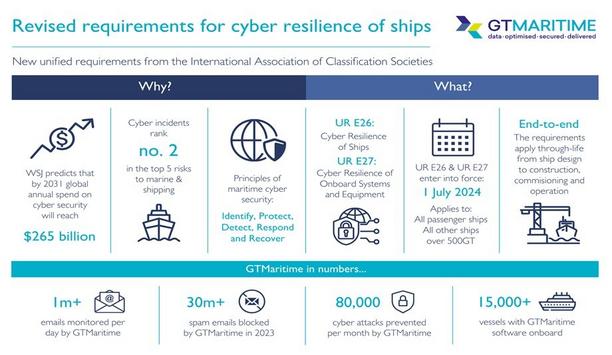GTMaritime - Experts & Thought Leaders
Latest GTMaritime news & announcements
A provider of secure maritime data communications software, GTMaritime, has launched a new remote access feature for GTMailPlus, which allows users to access their emails from anywhere, even if their onboard systems are offline. A recent Uptime Institute report revealed that 35% of businesses had experienced outages lasting more than eight hours in the last five years, with 54% reporting their most recent outage cost as over $100,000. GTMailPlus Cloud Access Available as standard to GTMailPlus customers, GTMailPlus Cloud Access enables seamless real-time synchronisation between ship and shore, ensuring uninterrupted communications for vessel operators. Users always have access to their emails from any device – desktop, tablet, or mobile – from anywhere in the world, without any need for additional backup solutions. Webmail-based service Automated mailbox synchronisation eliminates confusion and minimises strain on IT resources The secure webmail-based service is hosted within GTMaritime’s cloud infrastructure and requires no additional hardware or software. Customers can access their webmail anywhere, at any time, using their existing credentials, with customisable storage aligned with the user’s archiving settings. Automated mailbox synchronisation eliminates confusion and minimises strain on IT resources. Maintaining and retaining email access Jamie Jones, Operations Director at GTMaritime, said, "In today’s increasingly digitalised shipping industry, maintaining email access is crucial for keeping business operations up and running. With GTMailPlus Cloud Access, shipowners can stay connected anywhere, on any device to ensure that business operations run smoothly, with users retaining access to both live and historical emails even during system downtime." GTMailPlus Cloud Access is now available to GTMailPlus customers worldwide.
Major provider of secure maritime data communications software, GTMaritime, has unveiled an enhanced version of GTDeploy – the advanced fleet-management and diagnostics tool that helps owners get the best out of their operating systems. With unparalleled visibility into vessel assets and computer systems, IT teams now have a range of new key features to optimise performance, streamline operations, and mitigate cyber-security risks. Functionality of upgraded solution The upgraded solution includes the following functionality: Vessel and Computer Visibility: GTDeploy provides a centralised platform to view all vessels in the fleet and every computer onboard, enabling efficient asset management and oversight. Operating System Analysis: IT teams can now identify outdated operating software anywhere in the fleet, minimising the risk of cyber-attacks by ensuring timely updates and patches. Computer Performance Metrics: The upgraded solution displays crucial information such as the last reboot time, operating number, storage availability, and network connections for each computer, facilitating proactive diagnostics and inventory management. Software Inventory Management: IT teams gain access to information on installed software including name, manufacturer, version, installation date, and size, to enable informed decisions on software updates and removal. Service Monitoring: GTDeploy monitors services running on individual computers, supporting diagnostics and troubleshooting in the event of reported issues onboard. Streamlined Remote Diagnostics: The upgraded solution allows shoreside IT teams to access near-real-time data from ship computers, eliminating the need for remote log-in and expediting issue diagnosis and resolution to enhance operational efficiency and minimise downtime. Advanced asset-management and diagnostic tools Jamie Jones, Operations Director, GTMaritime, said: "This latest upgrade to GTDeploy is a massive step forward for the solution and continues our commitment to innovate as the needs of the maritime industry evolve." Jamie Jones adds, "Equipping IT teams with advanced asset-management and diagnostic tools empowers them to safeguard vessel operations, while optimising performance and cyber security." The enhanced GTDeploy is now available to GTMaritime customers worldwide.
At a time when rapid advancements in maritime connectivity and shipboard technology are leaving vessel networks increasingly vulnerable to attack, the International Association of Classification Societies’ (IACS) unified requirements (URs) E26 and E27 aim to minimise the frequency and impact of cyber incidents at sea. Revised E26 and E27 Initially adopted in April 2022, the URs were withdrawn ahead of their planned implementation on 1 January 2024. However, revised versions of E26 and E27 adopted in September 2023 and November 2023, respectively are set to enter into force on 1 July 2024. Below is an overview of the URs and the documentation maritime organisations will need to submit to their classification society to demonstrate compliance. UR E26: Cyber resilience of ships Relating to entire ships, IACS UR E26 aims to help maritime organisations establish and maintain an effective cyber-risk management system comprising five sub-goals corresponding with the five functions of the National Institute of Standards and Technology’s Cybersecurity Framework: Identify, Protect, Detect, Respond, and Recover. Demonstrating compliance with E26 requires the submission of documents relating to three stages of the vessel lifecycle: Design and construction: The systems integrator submits a zones and conduit diagram, a vessel asset inventory, and a cyber-security design description. Commissioning: The systems integrator submits a ship cyber-resilience test procedure. Operation: The ship owner submits a ship cyber-security and resilience programme. UR E27: Cyber resilience of onboard systems and equipment IACS UR E27 describes 30 security capabilities required by all computer-based systems (CBSs) Covering onboard systems and equipment, IACS UR E27 aims to help maritime organisations evaluate and improve cyber resilience. It describes 30 security capabilities required by all computer-based systems (CBSs) and a further 11 capabilities required by CBSs sharing an interface with untrusted networks. Demonstrating compliance with E27 requires the submission of a CBS asset inventory, CBS topology diagrams, a description of security capabilities, a test procedure of security capabilities, and security configuration guidelines. Outlook By providing full visibility of onboard CBSs and networks and ensuring they possess basic cyber-resilience capabilities, URs E26 and E27 will help maritime organisations to develop comprehensive risk-management policies and strengthen their cyber defences. However, to address the constantly evolving threat of cyber-attacks, specialist network security solutions are also needed. GTMaritime’s cyber-security offering combines next-generation anti-virus technology with end-point detection and response capabilities. This, combined with the enhanced security features included in all GTMaritime solutions, enables a holistic approach to vessel security.
Insights & Opinions from thought leaders at GTMaritime
Maritime communications came a long way before they could deliver the first Global Maritime Distress and Safety System (GMDSS). Still, it is fair to say that their forward march has only accelerated in the two-and-a-half decades since. Today, shipping companies rely on satellite connectivity to protect their vessels and people and enable the digitalisation, decarbonisation, and crew-welfare initiatives on which its successes rely. Low-Earth orbit (LEO) networks Against this background, the new generation of low-Earth orbit (LEO) networks has entered the maritime market to great fanfare and expectation from ship owners, and their excitement is justified: LEO satellite coverage has the potential to span the globe, providing exceptional reliability and speed even during long voyages in the most remote locations. This facilitates real-time communication and efficient coordination between vessels and onshore personnel, ultimately supporting more profitable and sustainable fleet operations. Level of connectivity Moral obligations and regulatory requirements aside, providing high-quality crew internet LEO’s introduction into the maritime sphere has been equally well received by seafarers, who stand to benefit from a level of connectivity that keeps them better connected to family and friends than ever before, and to richer entertainment options at sea. Moral obligations and regulatory requirements aside, providing high-quality crew internet represents a wise investment from a competitive standpoint, enhancing as it does an organisation’s ability to attract and retain the brightest talent. Another advantage to seafarers and their employers, LEO connectivity offers stable onboard access to non-leisure services including mental-health support, telemedicine, and online learning resources, helping to keep a crew happy, healthy, and up to speed with the evolving requirements of their job. Limitations For all the benefits of LEO networks, it is important to acknowledge their limitations. For instance, LEO’s promise of delivering worldwide coverage remains to be realised, with certain countries yet to authorise its use in their territorial waters. This means that, depending on the trading route, a ship may encounter multiple LEO-coverage blackspots during its voyage. Susceptible to interference Regardless of the network type being used, vessels still need to compress and throttle data Like many satellite technologies, LEO networks are also susceptible to interference from atmospheric conditions that can disrupt communications, while network congestion at hotspots and drop-out at satellite handover may present additional connectivity challenges. Regardless of the network type being used, vessels still need to compress and throttle data on certain occasions, such as while in port, but LEO networks currently cap utilisation and therefore limit connectivity and availability further. Crew and commercial use In addition, maritime organisations should consider whether their LEO system is for both crew and commercial use. For a vessel deploying LEO connectivity to cover crew and business communications simultaneously, even a terabyte of data is unlikely to go far. Divided among a crew of 25, it equates to 40 gigabytes per person, enough for 13 hours of HD streaming with nothing remaining for commercial requirements. The solution Maritime software including critical communications-based services will need to be compatible with LEO To ensure reliable and consistent connectivity, support enhanced GMDSS communications, and meet the bandwidth needs of all stakeholders, a vessel will require multiple satellite provisions. This means that maritime software including critical communications-based services will need to be compatible with both LEO and more traditional, low-bandwidth networks and be able to switch between connections automatically to ensure uninterrupted service. GTMailPlus GTMaritime’s GTMailPlus, for example, is compatible with all major network types, regardless of bandwidth. Developed with optimisation in the maritime environment in mind, it provides secure and efficient data transfers irrespective of the service or combination of services a shipowner or manager uses. If disruptions do occur, GTMailPlus resumes data transmission from the point of interruption. Risk of a cybersecurity breach There have already been several reported cases of ship owners falling victim to significant cyber incidents As crew freedoms on the Internet increase and more onboard devices are connected to the network, the risk of breaches to cybersecurity is also rising dramatically: effectively, the vessel becomes a larger attack surface. There have already been several reported cases of ship owners falling victim to significant cyber incidents having adopted LEO systems without taking the necessary security precautions. Robust, intelligent, and scalable network Given that ships transfer diverse types of data that often involve critical and sensitive information, the consequences of any breach of vessel operations, safety, and privacy can be severe. Here too, the GTMaritime portfolio is continuously evolving to ensure robust, intelligent, and scalable network protection for owners. AI-based next-gen anti-virus technology In addition to the enhanced security features included in all GTMaritime solutions, enables a holistic approach In the latest partnership with CrowdStrike, GTMaritime’s cyber-security offering combines AI-based next-generation anti-virus technology with end-point detection and response capabilities. This, in addition to the enhanced security features included in all GTMaritime solutions, enables a holistic approach to vessel security. Conclusion LEO networks undoubtedly present a considerable opportunity for the maritime industry and have the power to transform connectivity at sea. However, there are several factors to consider before adopting an LEO system and regardless of advances in technology, optimised solutions for critical communications, security, and data transfer remain essential.









